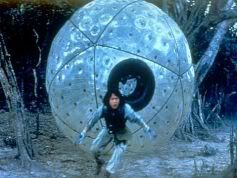i tried websites like that one Supersheep, but i wasn't too confident because it didn't mention anything about the changing Reynold's numbers that you get with a sphere. I wasn't sure if it had ignored Reynold's number issues to simplify the exersize.
It seems that the "Reynold's Number" for a particular object indicates whether the fluid/gas flowing past it is laminar or turbulent. This depends (this is especially the case with a sphere) on how fast the sphere is traveling.
ie: when the sphere is traveling at low velocitys, it's Reynold's number is low, it has a rather laminar (smooth) airflow around it. But if the sphere is going fast, the airflow is completely different - with vortexes and eddy currents forming - therefore showing that objects (especially spheres) have changing properties of aerodynamics which are dependant on the speed of the object.
(I guess this is all ULTRA important when dealing with scramjet engine designs, but that's another story)
Jakee, thx for the suggestion regarding the Mars Rover Missions. But those spacecraft are 900kg (+/- 100kg), that's approx 8x the weight in my project. Mars has different gravity, air density and weather. The airbags on the Rover missions are not used to slow the Rover's descent (traditional parachutes are used for that), they are just used to cushion that final impact. There were no Humans onboard so the landing could be of much higher G forces. And finally, the airbag configuration on the Rover lander is not spherical like the Zorb is.
It may help in estimating the cushioning ability of the Zorb for a landing though. But not useful in figuring out the terminal velocity of a Zorb (plus human) falling at low altitude in Earth atmosphere.
Actually, there is something else that maybe someone could help me with:
Does anyone have a recording of the Jackie Chan Movie "Armour of God II" / "Operation Condor" / "Fei ying gai wak" ?
http://www.imdb.com/title/tt0099558/
because there is a segment in that where Jackie Chan uses a ball similar to a Zorb, and rolls off a cliff with it. I'd like to see it.






